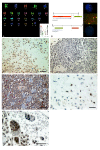A balanced t(5;17) (p15;q22-23) in chondroblastoma: frequency of the re-arrangement and analysis of the candidate genes
- PMID: 19903358
- PMCID: PMC2778658
- DOI: 10.1186/1471-2407-9-393
A balanced t(5;17) (p15;q22-23) in chondroblastoma: frequency of the re-arrangement and analysis of the candidate genes
Abstract
Background: Chondroblastoma is a benign cartilaginous tumour of bone that predominantly affects the epiphysis of long bones in young males. No recurrent chromosomal re-arrangements have so far been observed.
Methods: We identified an index case with a balanced translocation by Combined Binary Ratio-Fluorescent in situ Hybridisation (COBRA-FISH) karyotyping followed by breakpoint FISH mapping and array-Comparative Genomic Hybridisation (aCGH). Candidate region re-arrangement and candidate gene expression were subsequently investigated by interphase FISH and immunohistochemistry in another 14 cases.
Results: A balanced t(5;17)(p15;q22-23) was identified. In the index case, interphase FISH showed that the translocation was present only in mononucleated cells and was absent in the characteristic multinucleated giant cells. The t(5;17) translocation was not observed in the other cases studied. The breakpoint in 5p15 occurred close to the steroid reductase 5alpha1 (SRD5A1) gene. Expression of the protein was found in all cases tested. Similar expression was found for the sex steroid signalling-related molecules oestrogen receptor alpha and aromatase, while androgen receptors were only found in isolated cells in a few cases. The breakpoint in 17q22-23 was upstream of the carbonic anhydrase x (CA10) gene region and possibly involved gene-regulatory elements, which was indicated by the lack of CA10 protein expression in the index case. All other cases showed variable levels of CA10 expression, with low expression in three cases.
Conclusion: We report a novel t(5;17)(p15;q22-23) translocation in chondroblastoma without involvement of any of the two chromosomal regions in other cases studied. Our results indicate that the characteristic multinucleated giant cells in chondroblastoma do not have the same clonal origin as the mononuclear population, as they do not harbour the same translocation. We therefore hypothesise that they might be either reactive or originate from a distinct neoplastic clone, although the occurrence of two distinct clones is unlikely. Impairment of the CA10 gene might be pathogenetically relevant, as low expression was found in four cases. Diffuse expression of SRD5A1 and sex steroid signalling-related molecules confirms their role in neoplastic chondrogenesis.
Figures

Similar articles
-
Human benign chondroblastoma with a pseudodiploid stemline characterized by a complex and balanced translocation.Cancer Genet Cytogenet. 1992 Jan;58(1):14-7. doi: 10.1016/0165-4608(92)90126-s. Cancer Genet Cytogenet. 1992. PMID: 1728944
-
Analysis of balanced rearrangements of chromosome 6 in acute leukemia: clustered breakpoints in q22-q23 and possible involvement of c-MYB in a new recurrent translocation, t(6;7)(q23;q32 through 36).Haematologica. 2005 May;90(5):602-11. Haematologica. 2005. PMID: 15921375
-
Cryptic 17q22 deletion in a boy with a t(10;17)(p15.3;q22) translocation, multiple synostosis syndrome 1, and hypogonadotropic hypogonadism.Am J Med Genet A. 2008 Jun 1;146A(11):1458-61. doi: 10.1002/ajmg.a.32319. Am J Med Genet A. 2008. PMID: 18449926
-
Cytogenetic analysis of a scapular chondromyxoid fibroma.Cancer Genet Cytogenet. 1998 Jul 1;104(1):52-6. doi: 10.1016/s0165-4608(97)00450-0. Cancer Genet Cytogenet. 1998. PMID: 9648559 Review.
-
A case of presumptive monosomy 21 re-diagnosed as unbalanced t(5p;21q) by FISH and review of literature.Am J Med Genet. 1997 May 16;70(2):174-8. doi: 10.1002/(sici)1096-8628(19970516)70:2<174::aid-ajmg14>3.0.co;2-g. Am J Med Genet. 1997. PMID: 9128939 Review.
Cited by
-
Identification of DNA methylation patterns and biomarkers for clear-cell renal cell carcinoma by multi-omics data analysis.PeerJ. 2020 Aug 3;8:e9654. doi: 10.7717/peerj.9654. eCollection 2020. PeerJ. 2020. PMID: 32832275 Free PMC article.
-
Oestrogen receptor expression distinguishes non-ossifying fibroma from other giant cell containing bone tumours.Virchows Arch. 2022 Oct;481(4):671-675. doi: 10.1007/s00428-022-03341-4. Epub 2022 May 25. Virchows Arch. 2022. PMID: 35612673 Free PMC article.
-
Genome-wide characterization of pancreatic adenocarcinoma patients using next generation sequencing.PLoS One. 2012;7(10):e43192. doi: 10.1371/journal.pone.0043192. Epub 2012 Oct 10. PLoS One. 2012. PMID: 23071490 Free PMC article.
-
Heterogeneous and complex rearrangements of chromosome arm 6q in chondromyxoid fibroma: delineation of breakpoints and analysis of candidate target genes.Am J Pathol. 2010 Sep;177(3):1365-76. doi: 10.2353/ajpath.2010.091277. Epub 2010 Aug 9. Am J Pathol. 2010. PMID: 20696777 Free PMC article.
-
Integrated analysis of plasma proteome and cortex single-cell transcriptome reveals the novel biomarkers during cortical aging.Front Aging Neurosci. 2023 Jul 19;15:1063861. doi: 10.3389/fnagi.2023.1063861. eCollection 2023. Front Aging Neurosci. 2023. PMID: 37539343 Free PMC article.
References
-
- Berg H van den, Kroon HM, Slaar A, Hogendoorn PCW. Incidence of biopsy-proven bone tumors in children: a report based on the Dutch pathology registration "PALGA". J Pediatr Orthop. 2008;28:29–35. - PubMed
-
- Kilpatrick SE, Parisien M, Bridge JA. In: World Health Organization classification of tumours. Pathology and genetics of tumours of soft tissue and bone. Fletcher CDM, Unni KK, Mertens F, editor. Lyon: IARC Press; 2002. Chondroblastoma; pp. 241–242.
-
- Romeo S, Oosting J, Rozeman LB, Hameetman L, Taminiau AH, Cleton-Jansen AM, Bovee JVMG, Hogendoorn PCW. The role of noncartilage-specific molecules in differentiation of cartilaginous tumors: lessons from chondroblastoma and chondromyxoid fibroma. Cancer. 2007;110:385–394. doi: 10.1002/cncr.22798. - DOI - PubMed
Publication types
MeSH terms
LinkOut - more resources
Full Text Sources

